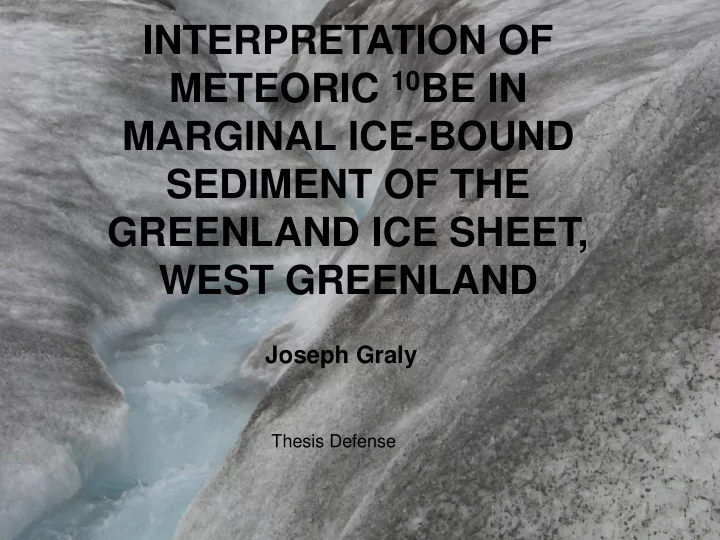

INTERPRETATION OF METEORIC 10 BE IN MARGINAL ICE-BOUND SEDIMENT OF THE GREENLAND ICE SHEET, WEST GREENLAND Joseph Graly Thesis Defense
Outline of Presentation • Project Motivation and Concept • Glaciological Background • Meteoric 10 Be and Atmospheric Processes • Meteoric 10 Be in Soils • West Greenland Results • Interpretation of Greenland Glacial History • Conclusions
Past Performance Predicts Future Results? Climate models for the Arctic for the present, last interglacial period (116- 130 ka before present) and 2100 (form Overpeck et. al., 2006) The temperatures modelled for Greenland are similar in the last Interglacial period and 2100
Meteoric 10 Be as a Tracer
Map of Greenland showing modern glacier flowlines (from Zwally and others, 2001) Locations of our three western Greenland field sites and central Greenland ice cores are shown The yellow lines indicate plausible source areas for rock and sediment delivered to the western Greenland sites
Six models of Eemian ice sheet retreat from the published literature. Approximate locations of our field sites at Kangerlussuaq (K), Ilulissat (L), and Upernavik (U) are marked. Models agree on substantial retreat at southern latitudes and more moderate retreat at northern latitudes
Data from Britanja and van de Wal, 2008
North Atlantic Glacial Erosion Rates
Typical Subglacial Processes According to Alley and others, 1997
Modern Sediment Transport Rate Based on a model by W.L. Wang
Meteoric 10 Be and Atmospheric Processes • What controls the distribution of meteoric 10 Be in Earth’s atmosphere? • Can the long-term meteoric 10 Be deposition rate be predicted at a given site?
Meteoric 10 Be deposition predicted by precipitation
Meteoric 10 Be deposition predicted by latitude
Meteoric 10 Be deposition in Polar Regions
Long-term Record: Marine Sediment
Long-term Record: Soils
Long-term Record: Greenland Ice Sheet
Meteoric 10 Be in Soils • How is meteoric 10 Be typically distributed in soils? • Can the effects of erosion of meteoric 10 Be bearing sediment be modeled from a typical depth distribution?
Existing work on meteoric 10 Be in soils
Typical Distribution with Depth
Declining Profile Shapes: Eroding Hillslopes Profiles from Contra Costa, California McKean et al, 1993
Declining Profile Shapes: Young Surfaces
Development of max accumulation zone
Maximum predictive of total inventory
Topsoil Meteoric 10 Be Concentration Predictive of Total Inventory
West Greenland Results and Interpretation • Which sites were sampled and what meteoric 10 Be measurements were made? • What can be inferred about the erosion and interglacial exposure of West Greenland?
Kangerlussuaq: Isunnguata Sermia Glacier
Kangerlussuaq: Dead Ice Zone
Ilulissat: Sermeq Avannarleq Glacier
Upernavik: Transect
Upernavik: Nunatak
West Greenland Meteoric 10 Be Results
Estimate of Meteoric 10 Be Inventory Soil Ages Upernavik: 60-122 ka Ilulissat: 39-78 ka Kangerlussuaq: 9-18 ka
Erosion model: Top 150 cm Pre-Glacial Inventory: N=q(1- E·α·(N/q) β )/( λ(1 -e - λt )) Interglacial Inventory: N=(q/λ)(1 -e - λt ) Inventory Lost to Glacial Erosion: N L =z·q·α·(N/q) β
Erosion Model: Deep Erosion
Glacial Sediment Transport Lag
Development of Modern 10 Be Inventory Data from Britanja and van de Wal, 2008 Years before present
Valid Erosion Exposure Interpretations
Glacial Erosion Rates Reconsidered
Interglacial Exposure Reconsidered Data from Britanja and van de Wal, 2008
Conclusions • Long-term meteoric 10 Be deposition rate is moderately predictable from precipitation and latitude • Meteoric 10 Be depth distribution is moderately predictable from total soil meteoric 10 Be inventory • Pre- Quaternary regolith under Greenland’s Main Dome has not completely eroded, with glacial erosion rates < 5 m/My • Greenland’s Southern Dome has experienced substantial interglacial exposure
Acknowledgements • National Science Foundation • CH2M HILL Polar Services (Kangerlussuaq) • Lawrence Livermore National Laboratory • Greenland Cosmochronology Project Team • Fellow geology grad students, family, and friends
Thanks for Listening… Any Questions?
West Greenland Stable Isotope Results Upernavik Transect Experimental Results, Iverson and Souchez, 1996
West Greenland Stable Isotope Results
Distribution Controlled by Soil Properties?
Grain Size Effect
Comparable Mobile Cations
CEC, Organic Carbon, and pH
Meteoric 10 Be deposition predicted by latitude
Recommend
More recommend